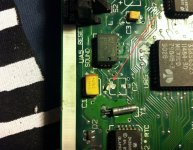uniserver
Well-known member
This is some re-work that i am doing for a member.
It was sent to me already re-capped with tantalums.
I am trying to diagnose issues with it.
Removing some caps i saw this.
You can see one of the pads, and what over soldering can do… it creates a big blotch of solder.
to where it looked just fine from the top, the over sized tantalum cap had all this concealed.
Now if the Silkscreen is intact then its fine, not really a problem.
if you have exposed traces, this can cause you issues, shorts / solder bridges.
Sometimes traces are ran right next to pads, sometimes they are ran under the cap in-between the pads.
This is why i never take chances and will only install high quality OEM Panasonic lytics (in situations like this) instead because,
I dont have time to mess around.

It was sent to me already re-capped with tantalums.
I am trying to diagnose issues with it.
Removing some caps i saw this.
You can see one of the pads, and what over soldering can do… it creates a big blotch of solder.
to where it looked just fine from the top, the over sized tantalum cap had all this concealed.
Now if the Silkscreen is intact then its fine, not really a problem.
if you have exposed traces, this can cause you issues, shorts / solder bridges.
Sometimes traces are ran right next to pads, sometimes they are ran under the cap in-between the pads.
This is why i never take chances and will only install high quality OEM Panasonic lytics (in situations like this) instead because,
I dont have time to mess around.

